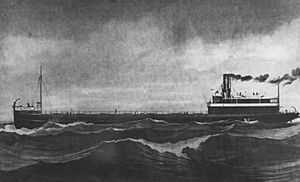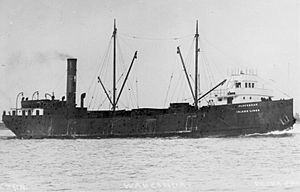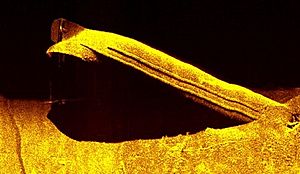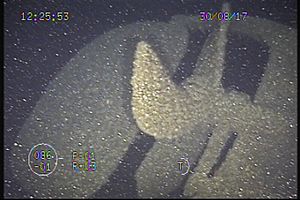SS Choctaw facts for kids

SS Choctaw
A painting by Great Lakes marine artist Howard Freeman Sprague (1871-1899), showing her in her original livery under the Lake Superior Iron Company (see "S" on funnel) |
|
Quick facts for kids History |
|
|---|---|
| Name | Choctaw |
| Namesake | Choctaw people |
| Operator |
|
| Port of registry | Ishpeming, Michigan, United States |
| Builder | Cleveland Shipbuilding Company |
| Yard number | 17 |
| Launched | May 25, 1892 |
| In service | June 24, 1892 |
| Out of service | July 11, 1915 |
| Identification | Registry number US 126874 |
| Fate | Rammed by the Canadian steamer Wahcondah on Lake Huron |
| General characteristics | |
| Class and type | Lake freighter |
| Tonnage |
|
| Length | 266.9 ft (81.4 m) |
| Beam | 38.1 ft (11.6 m) |
| Depth | 17.9 ft (5.5 m) |
| Installed power | |
| Propulsion | 1 × fixed pitch propeller |
| Capacity | 2,800 short tons (2,500 t) |
| Crew | 22 |
|
CHOCTAW (shipwreck)
|
|
| Location | Lake Huron, approximately five miles east of Presque Isle Light. |
| Built | 1892 |
| Built by | Cleveland Shipbuilding Company |
| Architectural style | Shipwreck site |
| NRHP reference No. | 100003214 |
| Added to NRHP | December 10, 2018 |
The SS Choctaw was an American cargo ship that sailed on the Great Lakes from 1892 to 1915. She had a special design, mixing parts of traditional lake freighters with the unique "whaleback" ships. These whaleback ships were invented by Alexander McDougall.
Choctaw was built in 1892 in Cleveland, Ohio. Her first owner was the Lake Superior Iron Company. In 1894, she was sold to the Cleveland-Cliffs Iron Company and stayed with them for the rest of her time on the water.
On July 11, 1915, Choctaw was sailing on Lake Huron. She was carrying coal from Cleveland to Marquette, Michigan. Because of thick fog, another ship, the Canadian steamer Wahcondah, crashed into her. Choctaw sank quickly after the collision.
For many years, people searched for the wreck of Choctaw because of her unusual design. A team from the Thunder Bay National Marine Sanctuary finally found her on May 23, 2017. This was almost 102 years after she sank! She was found resting about 300 feet (91 m) deep in the water. The wreck was added to the National Register of Historic Places on December 10, 2018.
Contents
History of the SS Choctaw
Building a Unique Ship
Choctaw was named after the Choctaw people, a Native American tribe from the southern United States. She was built in 1892 by the Cleveland Shipbuilding Company in Cleveland, Ohio.
The ship was 266.9 feet (81.4 m) long and 38.1 feet (11.6 m) wide. She could carry 2,800 short tons (2,500 t) of cargo. Choctaw was powered by a 900 hp (670 kW) triple expansion steam engine. This engine got its power from two coal-fired boilers.
Choctaw was one of only three "semi-whaleback" ships ever built. She had an identical sister ship called Andaste. Another ship, Yuma, looked very similar. These ships had a special design: they had straight sides like regular freighters, but their upper sides sloped inward. This made them look a bit like the famous whaleback ships. However, this design also meant their decks could get very wet in stormy weather.
Life on the Lakes
Choctaw started sailing on June 24, 1892. She had a few accidents during her time in service.
- On April 19, 1893, her engine exploded on Lake St. Clair. Two crew members died, and one was hurt.
- On May 20, 1896, Choctaw crashed into another ship, the L.C. Waldo. This made a 10 feet (3.0 m) hole in Choctaw's side. She sank onto a shallow area near the Soo Locks. She was later repaired.
- On May 26, 1900, Choctaw ran aground (got stuck on the bottom) near Pointe aux Pins on Lake Erie.
- On April 26, 1902, she hit a rock or the lake bottom near Marquette, Michigan. She partly sank after reaching the safety of Marquette Harbor.
Choctaw was in Marquette Harbor on November 9, 1913, during a huge storm called the Great Lakes Storm of 1913. Her captain, Charles Fox, saw the large freighter Henry B. Smith leave the harbor. This was the last time anyone saw the Henry B. Smith afloat. She was one of twelve ships lost in that terrible storm.
The Final Journey and Collision
On July 11, 1915, Lake Huron was very foggy. Choctaw, led by Captain Charles A. Fox, was heading to Marquette, Michigan, with coal. Around 5:30 a.m., the Wahcondah appeared through the fog. The Wahcondah was carrying wheat from Fort William, Ontario to Montreal.
Even though the Wahcondahs captain tried to stop, his ship crashed into Choctaws left side. The collision happened between Choctaws first and second cargo hatches. After the crash, the Wahcondahs crew lost sight of Choctaw in the fog. They found her again by seeing her tall smokestack.
Captain Fox quickly ordered his crew to get into the lifeboats. Choctaw sank so fast that some crew members had to jump into the water. All 22 crew members from Choctaw made it safely to the Wahcondah in their lifeboats. Choctaw sank in just 17 minutes. The Wahcondah then took Choctaw's crew to Sarnia, Ontario.
Captain Fox described the sinking: "We did not see the Wahcondah until she was within 10 feet (3.0 m) of us. She caught us on the port side... We put off in the lifeboats as quickly as possible... The Choctaw listed to port and began to go down at the head. Then she righted and began to list to the starboard. As she shifted to starboard her stern rose out of the water and she rolled over, going down bottom side up. We were in the yawl boats about 400 feet (120 m) away when she rolled. It sounded as if a million dishes and hundreds of sticks were being broken as the ship rolled over."
The day after the sinking, parts of Choctaw's upper cabins were seen floating near Presque Isle Township, Michigan. Nine days later, more pieces of her cabin were found.
Finding the Wreck of Choctaw
The Search Continues
Because of her special "straight-back" design, the Choctaw shipwreck was highly sought after by divers and shipwreck hunters. Many people tried to find her, but they often found other wrecks instead!
- In 2003, Stan Stock searched for Choctaw but found the schooner Kyle Spangler instead.
- In 2008, a team from the Thunder Bay National Marine Sanctuary and the University of Rhode Island looked for Choctaw. They found the passenger steamer Messenger instead.
- In 2011, a group of expert hunters and high school students tried to find Choctaw for a documentary called "Project Shiphunt". They didn't find Choctaw, but they did discover the wrecks of the freighter Etruria and the schooner M.F. Merrick.
The Discovery
Between April and July 2017, the Thunder Bay National Marine Sanctuary worked with the National Oceanic and Atmospheric Administration (NOAA). They were testing new equipment like drones and underwater robots to find missing shipwrecks.
On May 23, 2017, researchers from the Sanctuary found two shipwrecks in the deep waters of Lake Huron, off Presque Isle Township, Michigan. After more investigations, they confirmed the wrecks were the early wooden freighter Ohio and the Choctaw. The Ohio sank in 1894 after crashing with the schooner Ironton.
Both wrecks are in an area called "Shipwreck Alley." This is a 448 square miles (1,160 km2) part of the Lake Huron shoreline that has about 200 shipwrecks. The U.S. Federal Government made this area the nation's first National Freshwater Marine Sanctuary in 2000.
The Thunder Bay National Marine Sanctuary announced their discovery on September 1, 2017. However, independent shipwreck hunter Dan Fountain had already found Choctaw on August 13, 2017, using a special fishfinder. A week later, he returned with other experienced hunters, Ken Merryman and Jerry Eliason, and they confirmed it was indeed the Choctaw.
The Choctaw Today
The remains of the Choctaw lie about 300 feet (91 m) deep in the cold, fresh water of Lake Huron. When she sank, her captain said she "rolled over, going down bottom side up."
Today, the wreck rests on her right side, almost upside down. The upper part of her hull sticks up from the lake bottom. The top cabins at her stern (back) broke off when she sank, but the lower cabins are still there. The wreckage of her pilothouse (where the captain steered) is next to her hull.
The front part of the ship, including where the collision happened, is completely buried in the lake bottom. Only three of her seven cargo hatches can be seen. There is a large area of scattered items around the wreck, especially near her stern.
The Choctaw shipwreck was added to the National Register of Historic Places on December 10, 2018. This recognizes her importance in engineering and maritime history.
Images for kids









